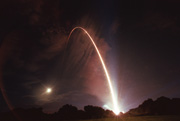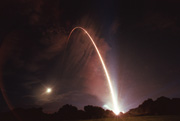
 SPACECRAFT
AND EXPENDABLE VEHICLES STATUS REPORT
SPACECRAFT
AND EXPENDABLE VEHICLES STATUS REPORT
September 18, 2002
KSC
contact: Bruce Buckingham
Kennedy
Space Center 321-867-2468
MISSION: Tracking and
Data Relay Satellite-J (TDRS-J)
LAUNCH VEHICLE: Lockheed
Martin Atlas IIA (AC-144)
LAUNCH SITE: Pad 36-A, Cape
Canaveral Air Force Station
LAUNCH DATE: November 20,
2002
LAUNCH WINDOW: 10:36
p.m. – 11:16 p.m. EST
The Atlas II
launch vehicle is at the Lockheed Martin factory in Denver, Colorado undergoing
final assembly, integration and testing.
Both Centaur stage engines have been installed. Associated electrical harnesses are
being installed and the aft area of the stage is undergoing electrical and
mechanical build-up. The arrival of the booster at Cape Canaveral Air Force
Station continues to be anticipated around October 8.
The TDRS-J spacecraft is undergoing testing at the
factory and is planned to arrive at Kennedy Space Center from the Boeing
Satellite Systems plant in El Segundo, California on or about October 17.
MISSION: Solar Radiation and Climate Experiment
(SORCE)
LAUNCH VEHICLE: Pegasus XL
LAUNCH LOCATION: Cape Canaveral Air Force Station
LAUNCH DATE:
December 1, 2002
LAUNCH WINDOW: 3:10 p.m. – 4:10 p.m. EST
SORCE is at
the Orbital Space Systems Group spacecraft facility in Dulles, Virginia and has
satisfactorily completed space environment tests. The spacecraft is scheduled to arrive at Kennedy Space
Center to begin final processing on October 25.
The Orbital
Sciences Pegasus XL launch vehicle continues to undergo buildup and testing at
Vandenberg Air Force Base. Two
Flight Simulation tests are scheduled while the vehicle is in California. Flight Simulation No. 1 is scheduled
for October 1 and will be followed by Flight Simulation No. 2 on October 9.
The Pegasus
is scheduled for ferry to Cape Canaveral using the Orbital Sciences L-1011
aircraft on October 28. Three
Flight Simulation tests are also planned at KSC prior to launch and are
scheduled to occur on November 1, November 8 and November 18.
MISSION: Ice, Cloud and Land Elevation Satellite
(ICESAT) and the Cosmic Hot Interstellar Spectrometer (CHIPSAT)
LAUNCH VEHICLE: Delta II w/Dual Payload Attach Fixture
(DPAF)
LAUNCH SITE: SLC-2W Vandenberg Air Force Base (VAFB)
LAUNCH DATE: NET December 15, 2002
LAUNCH WINDOW: 4:09:32 – 5::32:00 p.m. PST
The ICESAT
spacecraft is at the Ball Aerospace Facility in Boulder Colorado currently undergoing
workmanship vibration testing. The ICESAT spacecraft is scheduled to arrive at
Vandenberg Air Force Base on October 29.
The
CHIPSAT spacecraft is at Kirkland Air Force Base, New Mexico where it just
concluded vibration testing and is being prepped to undergo thermal vacuum
testing starting next week. The CHIPSAT spacecraft is scheduled to arrive at
VAFB on October 15.
The
Delta II first and second stage arrived at VAFB last week after successfully
completing its combined checkout at CCAFS. The booster is scheduled for
erection October 22 at VAFB.
# # #
 SPACECRAFT
AND EXPENDABLE VEHICLES STATUS REPORT
SPACECRAFT
AND EXPENDABLE VEHICLES STATUS REPORT